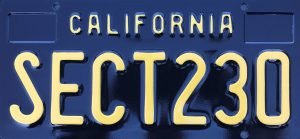eBay Isn’t Liable for Merchants’ Sales of Items That Violate Environmental Laws–US v. eBay
The EPA civilly sued eBay for third-party merchant listings of items that violate environmental laws. For example, the EPA identified over 300k aftermarket “defeat device” listings, 5k+ listings for products containing methylene chloride, and 23k listings for violative pesticides. eBay defeats the lawsuit.
Is eBay the “Seller”?
The Clean Air Act applies to someone who “manufactures,””sells,” or “offers to sell” a defeat device. eBay said that it didn’t engage in any of those activities (though its merchants may have). The court concludes that “to ‘sell’ an item one must either possess the physical item or its title,” neither of which eBay does. The EPA further argued that eBay “caused” its merchants to sell defeat devices. The court rejects this too:
eBay’s creation of product listings; “manipulating a consumer’s search results; pushing ‘related products,’ ‘similar sponsored items,’ and ‘sponsored items based on [] recent views’; sending coupons; and following a consumer all over the web[,]” is insufficient to constitute inducement of a sale
The court applies the same logic to the other claims. However, with respect to methylene chloride, the statute also applies to someone who “introduce[s] or deliver[s] for introduction into commerce,” and eBay couldn’t define this phrase to the court’s satisfaction. Thus, eBay might be a distributor and retailer of methylene chloride items.
Section 230
 eBay argued that the claims hold it responsible for its merchants’ listings. The EPA argued that eBay had “pervasive control over every aspect of the transaction on its website” such that the sales become its first-party activity. The court disagrees:
eBay argued that the claims hold it responsible for its merchants’ listings. The EPA argued that eBay had “pervasive control over every aspect of the transaction on its website” such that the sales become its first-party activity. The court disagrees:
The provision of neutral, automatic email prompts and messages, and of payment processing software does not materially contribute to the illegal products’ “alleged unlawfulness”
Thus, the court dismisses the EPA’s claims entirely.
This ruling resembles the US. v EZ Lynk case I blogged in April, strangely not cited by the judge. In that case, the defendant created a marketplace for aftermarket car apps, which naturally included defeat devices. The EZ Lynk court held that the marketplace qualified for Section 230–what I characterized at the time as “an embarrassing loss for the government.” Having apparently not learned from that case, the EPA tried the same arguments against a more sympathetic defendant (eBay) and got an unsurprising outcome. 🤷♂️
Reminder: if the EPA, through the USDOJ, had brought a criminal claim against eBay, Section 230 would have been categorically inapplicable. Section 230 only came into play because the EPA pursued civil recourse.
Case Citation: U.S. v. eBay Inc., 2024 WL 4350523 (E.D.N.Y. Sept. 30, 2024)
* * *
BONUS: In the Matter of Amazon.com, Inc., CPSC Docket No. 21-2 (U.S. Consumer Product Safety Commission July 29, 2024).
The CPSC issued an administrative ruling holding that Amazon “distributed” over 400k items that were safety hazards, such as flammable children’s sleepwear, inaccurate CO2 monitors, and hair dryers with inadequate protections if they are immersed. The CPSC notified Amazon of these violations, but Amazon didn’t recall the items. Instead, it sent weakly worded messages to buyers via email and their Amazon accounts. (Presumably the downplayed language was designed to discourage class action lawsuits). Amazon also told buyers to toss the items, rather than return them, and gave them gift cards rather than refunds.
The commission highlights Amazon’s key role in FBA merchant sales: “From pricing and payment processing to packaging, delivery, and tracking on the front end to post-sale customer service, returns, refunds, and recalls on the back end, Amazon exerts extensive control over products sold through its Fulfilled by Amazon program.” The commission explains:
Amazon fit squarely within the definition of distributor in the CPSA when it operated its Fulfilled by Amazon program [due to] Amazon’s extensive control over these products, beginning with receipt of a Fulfilled by Amazon participant’s products at an Amazon distribution center, and storage of this inventory until it is purchased by and shipped to a consumer.
The commission emphasizes that Amazon can be the distributor even if it never takes title to the goods.
The commission ordered Amazon to take the following steps with respect to the identified hazardous items:
- Send a more explicit recall notice to the public, not just initial buyers.
- Provide full refunds only after destruction or return of the items (so the items can’t pose future risks to consumers).
The CPSC ruling might be consistent with the eBay ruling. Amazon “possessed” any goods where it provided Fulfilled By Amazon services, while eBay didn’t possess any goods. Furthermore, the CPSC statutes use the same phrase “introduce[s] or deliver[s] for introduction into commerce” that the eBay court found was satisfied in eBay’s case (at least until Section 230 got applied).
Still, I’m not sure what to make of this ruling as extended to other items in Amazon’s vast catalog that the CPSC might declare as hazardous. Would the CPSC’s position stand up in court, when Section 230 might be in play? How does Loper Bright affect the CPSC’s authority here? Will Amazon decide to comply with CPSC demands, even if it could defeat liability, as a gesture towards protecting its customers?
I reiterate that Amazon lost only with respect to FBA items, and the ruling would presumably apply to any items Amazon retailed itself. Non-FBA marketplace items are not covered by this ruling.
